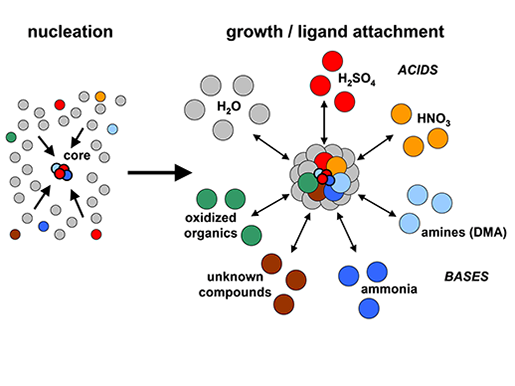Research | the nanoTOF project
Aerosol particles affect human life in many ways: health issues and respiratory problems are linked to air pollution; smoke, fog and smog strongly decrease visibility. But most important, aerosols strongly contribute to Earth’s radiative balance and play a key role in climate change (IPCC, 2013): as a direct effect, aerosols scatter sunlight directly back into space and even more important as an indirect effect, aerosols can influence the microphysical properties of clouds and thereby the forcing of short- and long-wave radiative fluxes. As the magnitude of the aerosols’ impact on Earth’s climate is still highly uncertain, there is a critical need for more in depth investigations.
Atmospheric New Particle Formation (NPF) is a ubiquitous phenomenon in Earth’s atmosphere (Kulmala et al. 2007, Kulmala et al. 2013). This nucleation process starts with the aggregation of gas molecules to charged and uncharged molecular clusters forming critical clusters that are able to grow to larger agglomerates and further to aerosol particles, which can act as Cloud Condensation Nuclei (CCN). Recent studies indicate that NPF is an important source of atmospheric particles and significantly contributes up to 50% to global CCN levels (Spracklen et al. 2008, Merikanto et al. 2009). Uncertainties in the mechanistic understanding of CCN formation further results in major uncertainties in the radiative forcing by atmospheric aerosols (Kerminen et al. 2012).
This project highlights the question whether the contributing mechanisms are correctly depicted by the present understanding of NPF. Here, we will offer an alternative approach for the used instrumentation: a new and innovative prototype mass spectrometer that involves a mobility classification and controlled collision induced dissociation of clusters; the nanoTOF.
With the nanoTOF, the ultimate goal of the project is to solve the ambiguity whether the currently used instrumentation can fully depict the processes of atmospheric NPF on the molecular level. We further want to identify the basic - so far unknown - building blocks of the the clusters participating in atmospheric NPF and to characterize the clusters according to their chemical compositions.

Current understanding of new particle formation in the atmosphere is strongly limited by the lack of knowledge of the chemical compounds that take part in the nucleation and growth process. On the left-hand-side a new cluster is formed from nucleating ionic or neutral gas-phase species. If this cluster is stable enough, additional ligands like water, various gas-phase acids and bases or oxidized organic compounds will condense on the core cluster to initiate the growth process.
